Drainage problems and issues with moving water are common challenges for homeowners. They can originate from the way the site was developed when the home was constructed and may become worse over time, depending on the neighboring topography and changes to neighborhood drainage. Opinions differ on the best ways to handle stormwater, and it’s helpful to know your options and be familiar with stormwater management techniques when hiring a professional to undertake grading and site work.
The movement of water in the landscape is a big design opportunity, because the relationship between water and ground can take many forms. Water can be moved on the surface with swales, underground with drainage pipes or in combination. Read on to learn how swales work to move water, when they should be used in conjunction with other techniques and when subdrainage may work best.
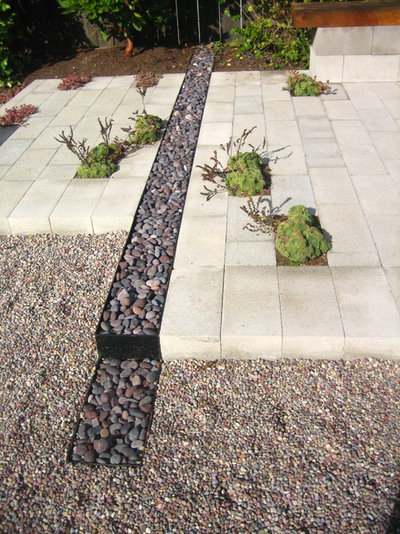
Terra Ferma Landscapes
Ways to Move WaterSwales: Swales are shallow, elongated depressions in the land that collect and move water. They are visible in the landscape and often highlight the movement of water through their material choices and layout. Swales move water, but they also slow it down and allow it to percolate back into the ground to improve water quality.
Subdrainage: Subdrainage consists of underground constructed drainage systems, including drainpipes and drain inlets, that collect and move water. Because it is buried in the landscape, subdrainage is often invisible to us. Buried drainage moves water quickly and efficiently across the landscape.
A mixture of the two: Swales can be used in conjunction with subdrainage. An example would be when a swale is used to move water from a roof downspout across the landscape to a drain inlet.
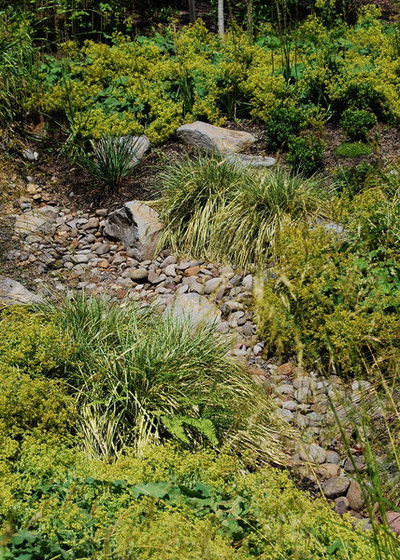
Samuel H. Williamson Associates
The Benefit of SwalesFor a long time, buried drainage systems were considered the most effective way to move water in the landscape because of their speed and efficiency. In recent years, however, the best practices have changed, and now landscape architects and engineers favor “daylighting” the movement of water. That means bringing water movement up to the surface to expose it to sunlight — which is good for water quality — and to keep the movement of water visible in the landscape. We have also learned that moving water too quickly can lead to flooding downstream.
There’s a balance that has to be achieved between moving stormwater runoff away from the home and across the landscape, and handling it in a way that allows the water to slowly infiltrate. Cities are looking at ways to decrease the runoff going into the sewer systems in response to these lessons learned. The city of Seattle has a great guide with tips for disconnecting your roof downspout so that roof runoff can be handled with swales and rain gardens instead of going into the combined sewer.
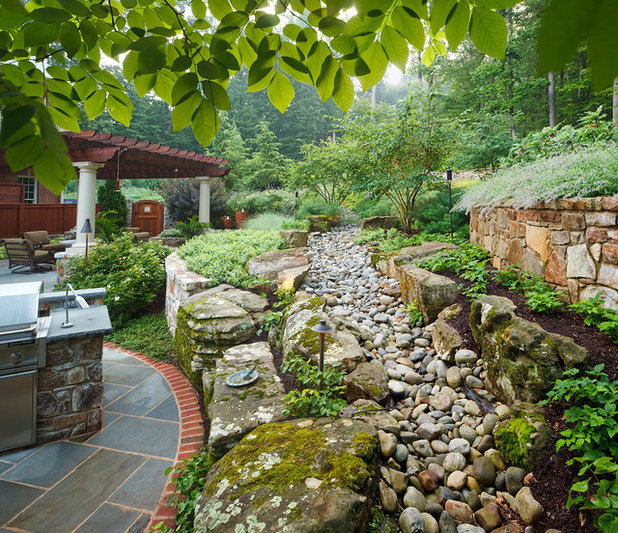
SURROUNDS Landscape Architecture + Construction
The rock swale in this image is somewhat unusual in that it’s nestled along a terraced planting. The image foreground is the swale’s low point, so when the rain comes, it flows parallel to the slope toward the foreground. This is a smart drainage solution for a rocky landscape with a steep slope, because it channels water across the hill and away from the outdoor entertaining area.
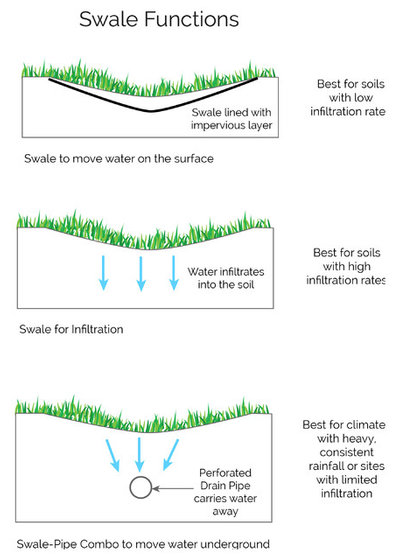
Falon Land Studio LLC
Swale functions. Swales are an environmentally friendly way to move and infiltrate water and can have many forms and functions within the home landscape, depending on the soil and climate conditions. Infiltration rate is a measurement of how fast water flows through soil and depends on a variety of factors, including soil texture, the amount of water coming in and how saturated the soil already is.
Swales for water movement are either used in areas with poor soil infiltration rates, or the swale is designed so that the water moves in the swale instead of soaking into the ground. In that case there is usually an impervious layer, like engineered clay or a geotextile fabric, lining the swale to prevent infiltration.
Swales for infiltration are best for areas with soil that has a high infiltration rate. With a very gradual slope, a swale can move water and allow some infiltration into the ground. Using a swale for infiltration helps reduce the overall runoff from a property.
A third type of swale works in conjunction with a perforated drainpipe to move water underground. The swale-pipe combo functions like a trench that collects water on the surface; the water flows to the perforated drainpipe at the bottom of the trench and then finally along the sloped drain to move water. The combination swale is more common in areas with high rainfall and sites with large amounts of stormwater runoff.
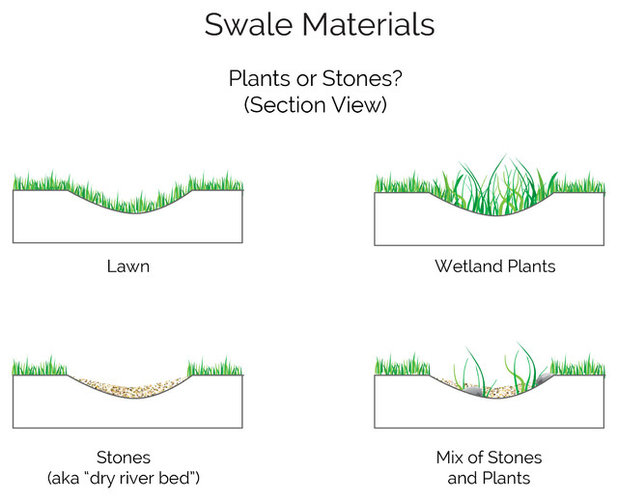
Falon Land Studio LLC
Swale materials. Material selection is where the fun begins, because the materials impact the appearance of the swale, as well as the landscape’s overall style and design. There are four main swale styles, and each has its appropriate use depending on the look you want for your landscape.
- Lawn: The most basic swale is simply planted with lawn and sloped so that it moves water and can still be maintained with a lawn mower.
- Wetland plants: Another style of swale is planted with native wetland plants that can handle periodic inundation as well as drought. Native wetland plants that usually grow on the edges of streams and ponds are good candidates for this type of swale. Local groups that advocate for swales in home landscapes usually publish great lists of local, native plants to use in swales.
- Stones: The stone swale is filled with rocks and is often called a dry streambed or dry creek bed when curvy. Rock swales have many names, some originating from naturally occurring transient waterways: dry creek bed, dry riverbed, arroyo, wash, wadi, vernal stream.
- Mix of stones and plants: The final type uses a mix of plants and stones to create a naturalistic garden swale.
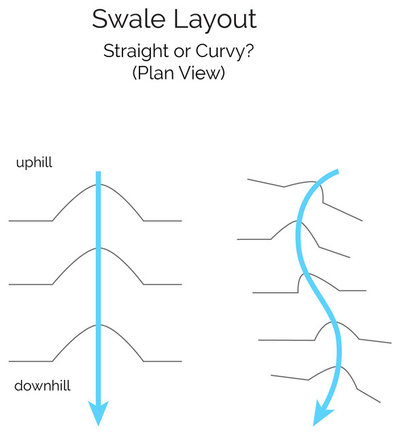
Falon Land Studio LLC
Swale layout. Swales can have any layout that works within the overall grading plan. A swale can be straight or curvy. The basic parameters for swales are that they should be sloped and sized to accommodate rainfall for the climate and site where they are being built. Straight swales are best when they can be gradually sloped and used for infiltration. Curvy swales are preferable to straight ones for moving water, because the curves break up the water energy as it moves, allowing the water to meander through the site.
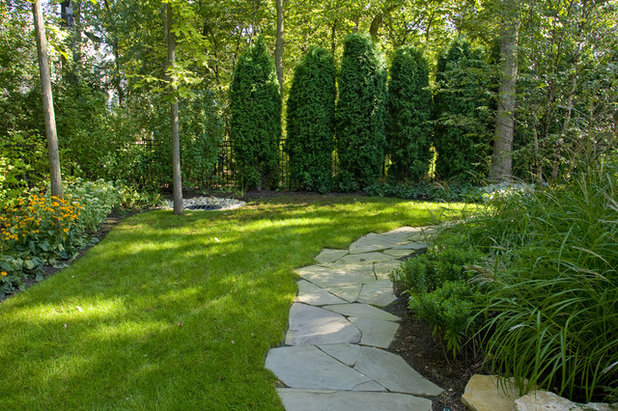
Arrow. Land + Structures
When Drainage Should Go UndergroundSubdrainage is preferred when there is not enough ground to work with for shaping and grading a swale that can handle all of the stormwater runoff. Tight urban courtyards are an example of when a homeowner might opt for buried drainpipes to carry away roof runoff from a large home. Subdrainage is hidden, occurring in underground systems of concrete catch basins and PVC pipes. Subdrains have become less popular as swales have grown in popularity.
Swales can be used in conjunction with drain inlets or buried drains when there is not a sufficient infiltration area. Drain inlets are also often used as backup drainage for rain gardens. The rain garden is designed to handle runoff from the majority of storms, but in the event of a major 100-year storm, the overflow water will have a place to go via a drain inlet that connects to the city system.
The far corner of the yard in this photo has a drain inlet that connects to a larger pipe drainage system. Drain inlets can be used in small urban gardens that do not have space for swales or do not have adequate soil depth for infiltration. Sometimes there just is not enough space on the ground to handle the runoff. The slope of the site is also ultimately related to the size of the yard, because a swale requires more space to meander along with check dams and terracing on a steep site.
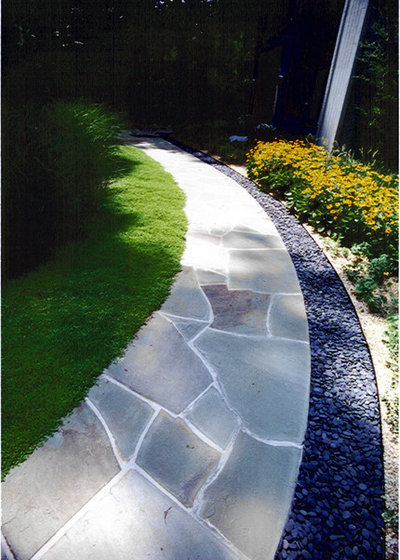
Anthony Wilder Design/Build, Inc.
Perforated drains can be used as hidden drainage structures underground to collect and move water in poorly draining soils. Buried drains effectively pull moisture away from foundation walls and move water away from site walls and other structures.
The Best Method for YouYou should choose the best option based on your site conditions and in consultation with a landscape architect. Ideally, the landscape architect will design a system that works best for the overall site. The cost of these systems depends on the amount of site grading and hard structures required for installation. Landscape contractors who regularly build swales and do major grading will most likely have a competitive price for doing this kind of work. I recommend getting several opinions before proceeding with the work. In considering your options, the size of your yard and the amount of runoff will be the biggest factors in determining the best method.





